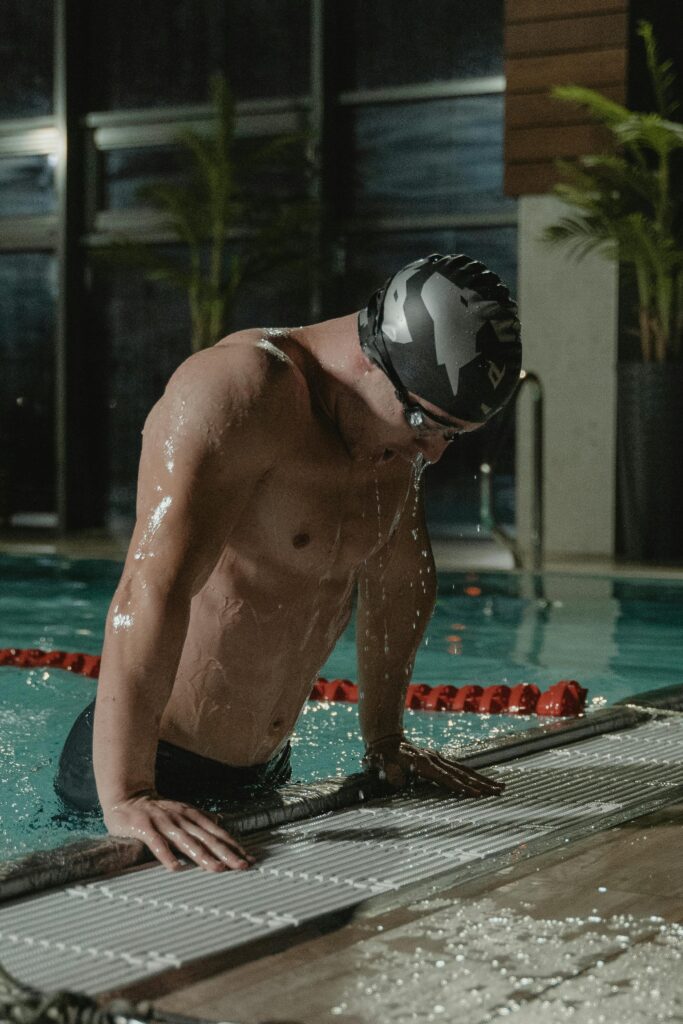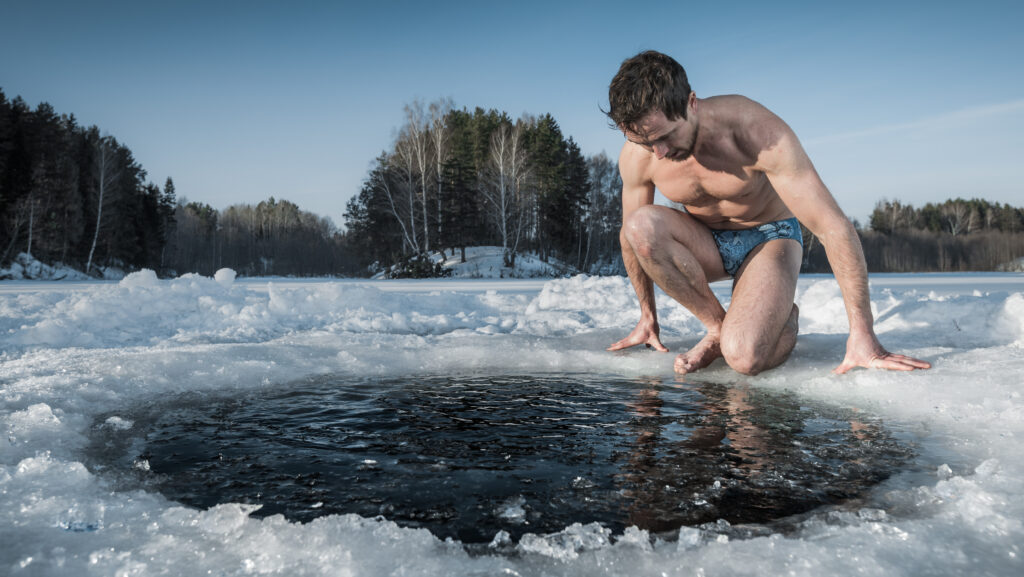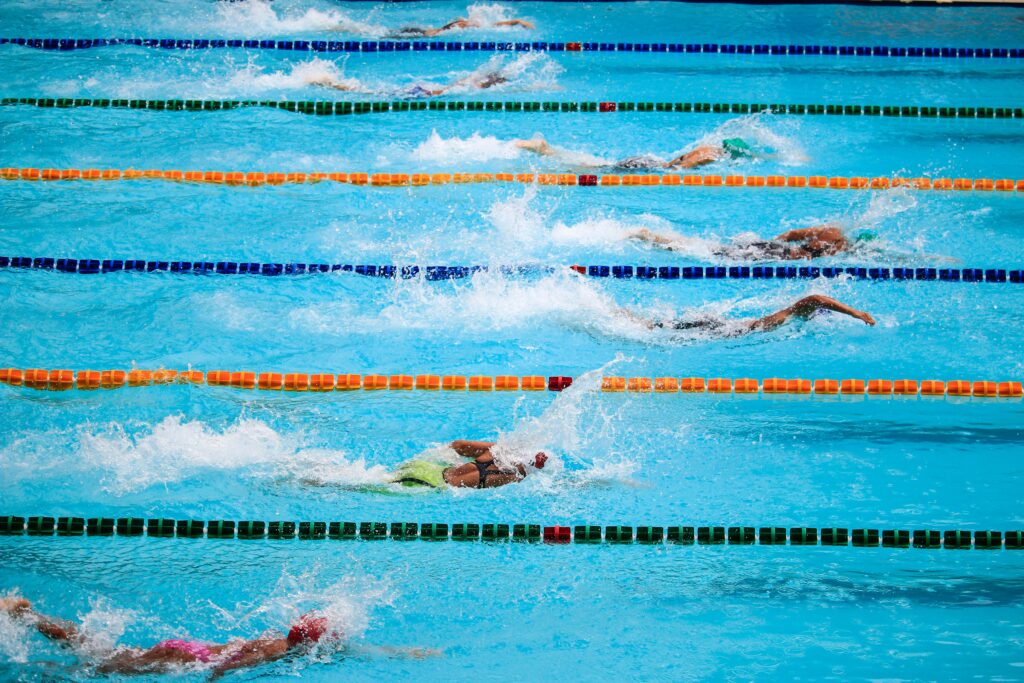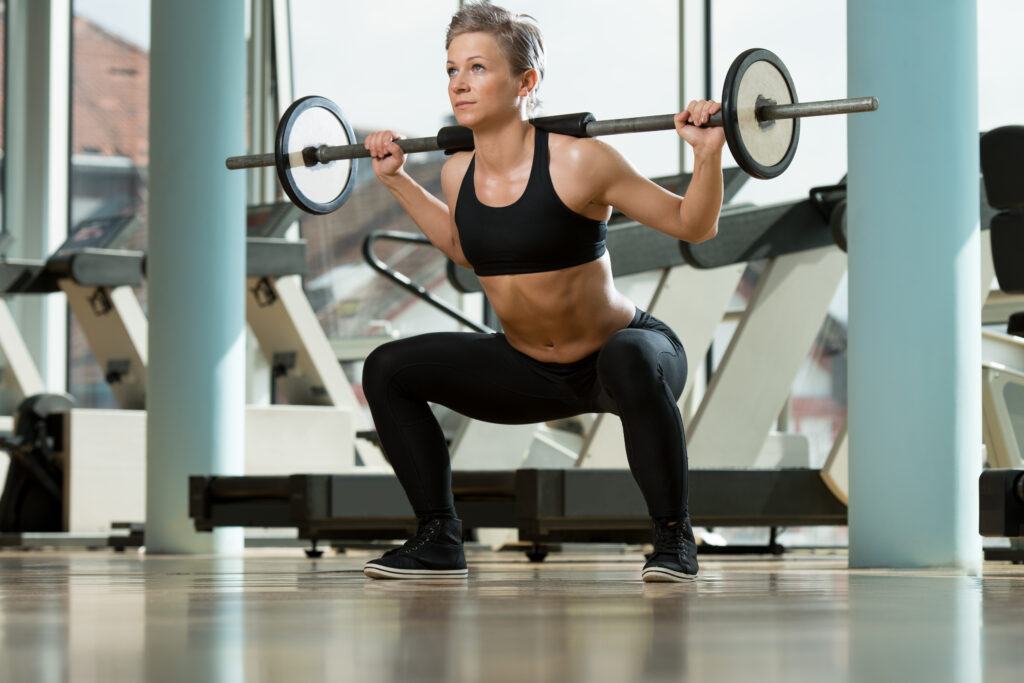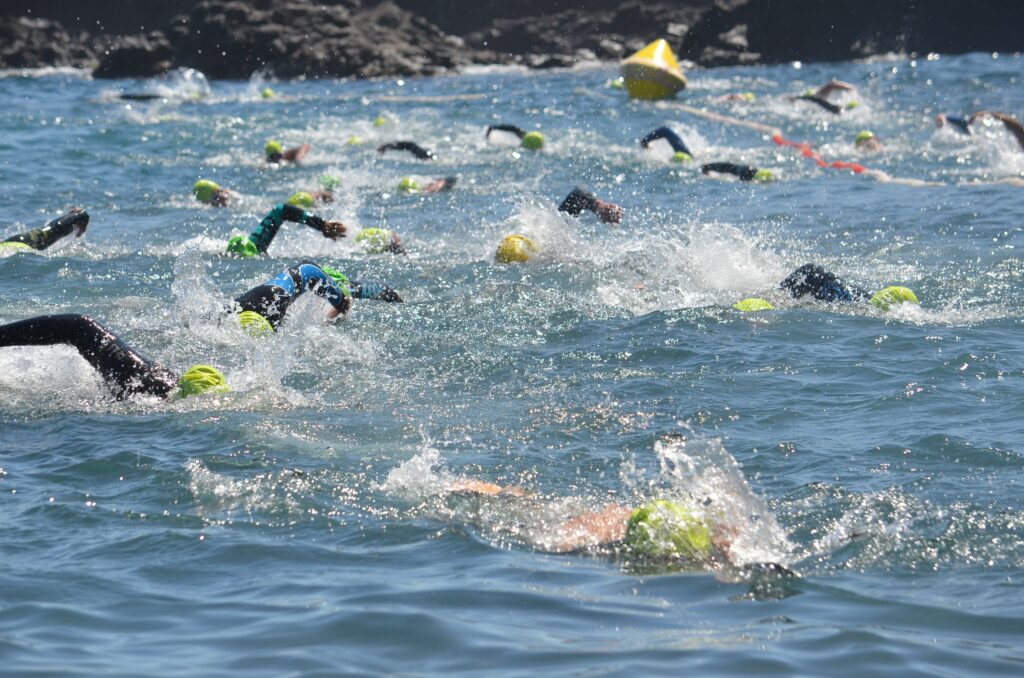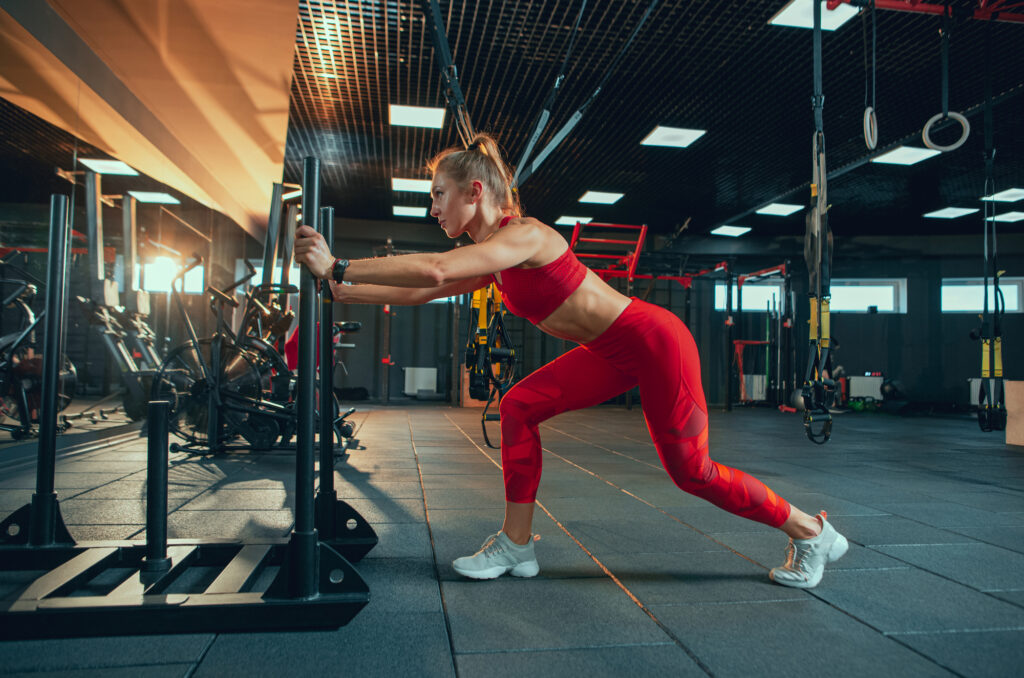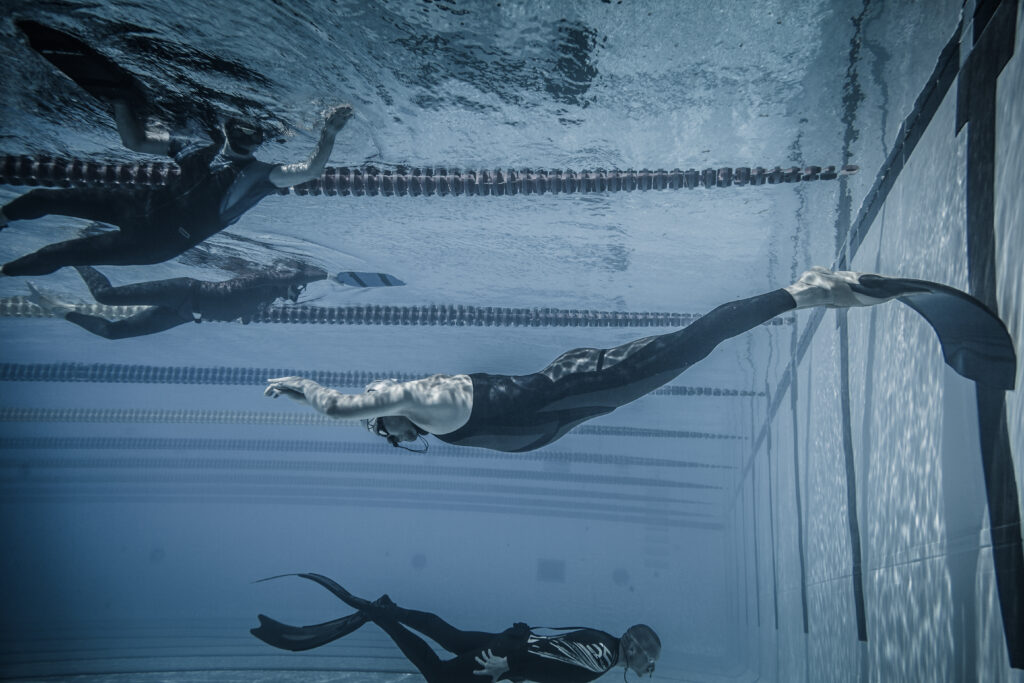Swimming breaststroke is a great way to get fit and work out many muscles at once. This stroke uses a unique technique that engages muscles throughout the body. The main muscle groups worked during breaststroke are the chest, upper back, arms, legs, and core.
The chest and upper back muscles power the arm movements in breaststroke. The pectoralis major and latissimus dorsi contract to pull the arms through the water. In the legs, the quadriceps and hamstrings drive the frog kick that propels swimmers forward. The core muscles, including the abdominals and lower back, help maintain proper body position.
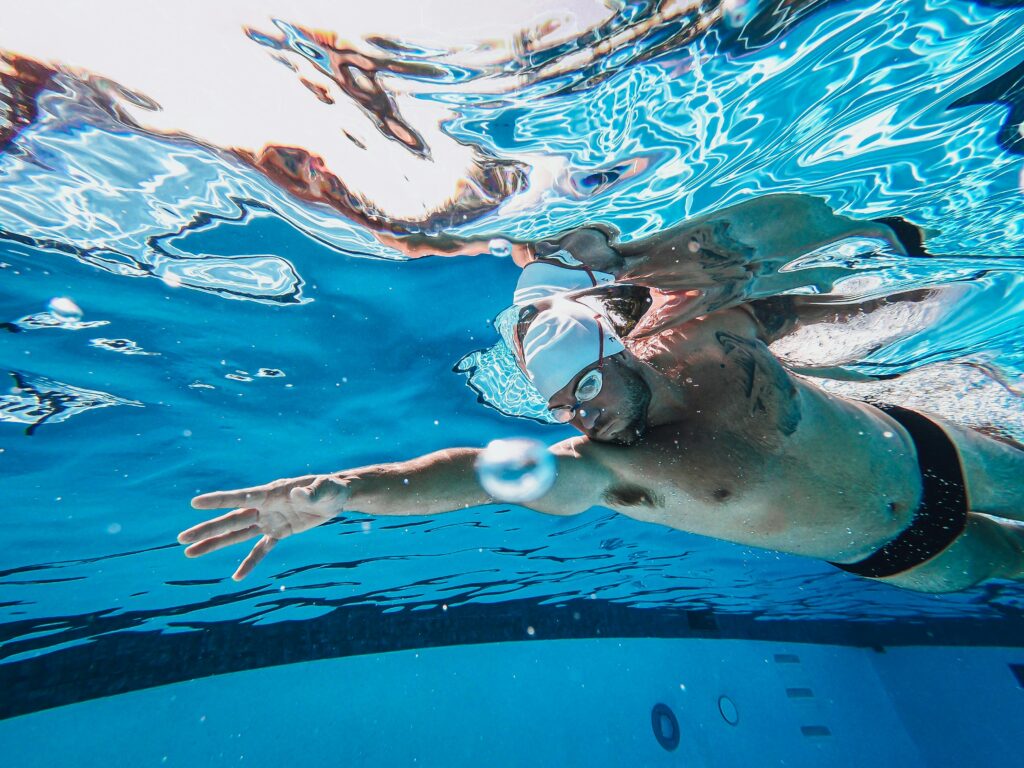
Breaststroke offers a full-body workout that improves strength and cardiovascular fitness. The rhythmic movements tone muscles while building endurance. With proper technique and efficiency, swimmers can maximise the benefits to these key muscle groups. Regular breaststroke swimming can lead to improved muscle tone and overall fitness.
Understanding Breaststroke Technique
Breaststroke technique involves coordinating body position, leg movements, arm strokes, and breathing. Proper form helps swimmers move efficiently through the water and maximise propulsion.
Body Position and Propulsion
Maintaining a streamlined position is crucial for breaststroke efficiency. Swimmers should keep their bodies as horizontal as possible, with hips high in the water. This reduces drag and improves propulsion.
The head position is key. Swimmers should look down and slightly forward, keeping the water line at the hairline. This helps maintain proper body alignment.
During the glide phase, swimmers extend their arms and legs fully. This streamlined position allows them to slice through the water with minimal resistance.
The Breaststroke Kick
The breaststroke kick, often called the ‘whip kick’, is a powerful source of propulsion. It begins with the legs bent and feet drawn up towards the buttocks.
Key muscles involved in the kick include:
- Glutes
- Hamstrings
- Quadriceps
- Calf muscles
Flexibility in the ankles is crucial. Swimmers should turn their feet outward, with soles facing behind them. This position allows for a strong backward push against the water.
The kick ends with legs coming together in a streamlined position. This helps maintain momentum between strokes.
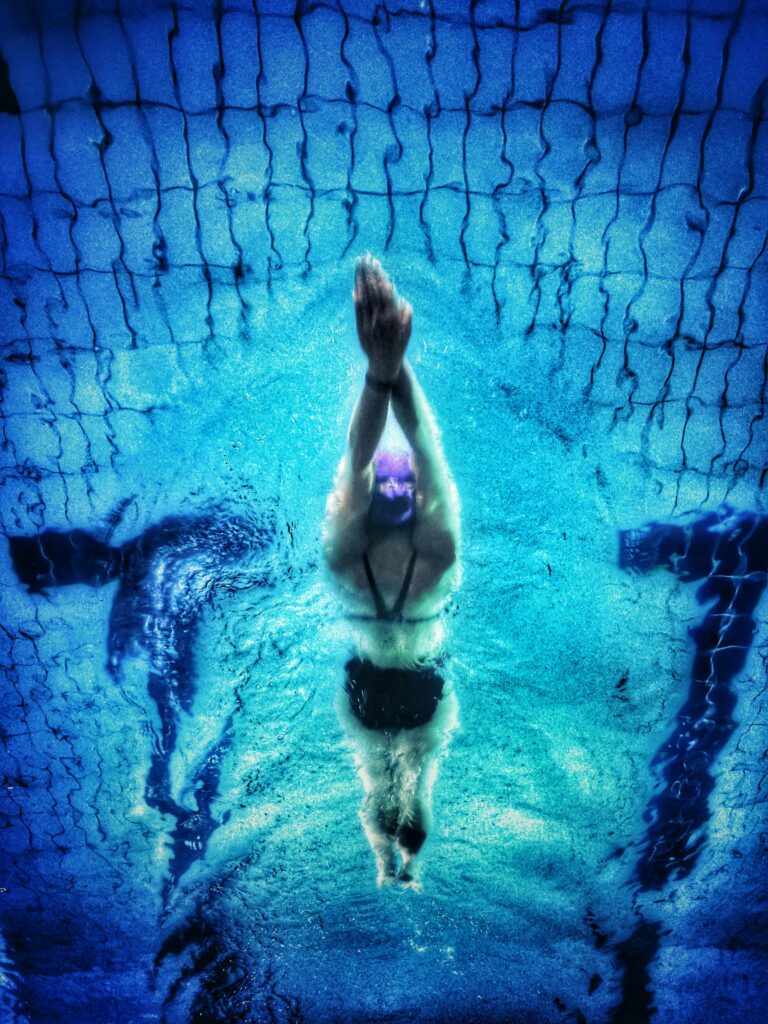
Arm Movements and Catch Phase
Breaststroke arm movements are symmetrical and occur mostly underwater. The stroke begins with arms extended forward in a streamlined position.
The ‘catch’ phase is when hands sweep outward and slightly downward. This creates resistance against the water, engaging upper body muscles like pectorals, biceps, and triceps.
After the catch, arms sweep inward and backward. This ‘pull’ phase provides the main propulsion from the upper body. Hands should accelerate through this movement.
The recovery phase brings arms forward underwater. Elbows should stay close to the body to reduce drag.
Breathing and Rhythm
Proper breathing technique is essential for breaststroke efficiency. Swimmers inhale when their head is above water during the arm recovery phase.
Exhalation occurs underwater as arms extend forward. This helps maintain a steady rhythm and prevents holding breath, which can lead to fatigue.
Coordinating breathing with arm and leg movements is crucial. A typical breaststroke rhythm follows this pattern:
- Pull with arms
- Breathe
- Kick
- Glide
Maintaining a consistent stroke rate helps swimmers find their optimal rhythm. This improves efficiency and reduces energy expenditure.
Regular practice of these techniques can improve breaststroke performance and provide an excellent cardiovascular workout.
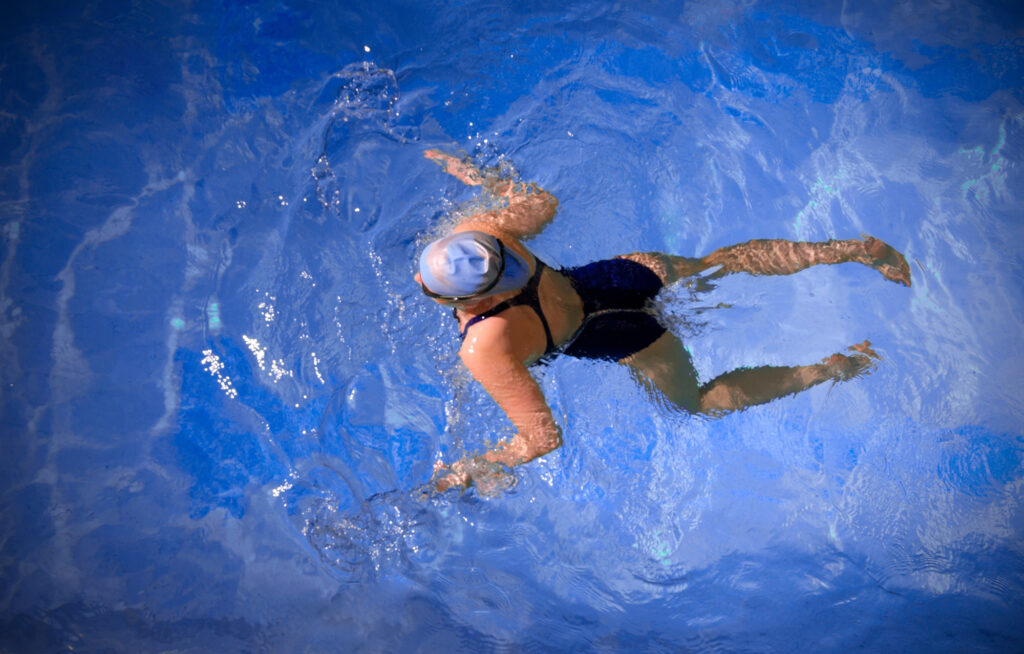
Major Muscle Groups in Breaststroke
Breaststroke engages multiple muscle groups throughout the body. It provides a full-body workout that targets the upper body, core, and lower body muscles.
Chest and Back Muscles
The pectoralis major and latissimus dorsi are key muscles used in breaststroke. These large muscles in the chest and back power the arm movements.
The pectoralis major helps pull the arms inward during the stroke. It works hard during the arm recovery phase.
The latissimus dorsi, or ‘lats’, assist in pulling the arms backward through the water. This creates propulsion in the pull phase.
The trapezius muscles in the upper back also activate to stabilise the shoulder blades during arm movements.
Arm and Shoulder Muscles
The arms and shoulders play a crucial role in breaststroke technique. Several muscles in this area work together to execute the stroke.
The deltoids, biceps, and triceps are primary arm muscles used. Deltoids raise the arms during the recovery phase. Biceps bend the elbow as the hands come together. Triceps extend the elbow to push water backwards.
The brachialis and brachioradialis in the forearm assist with arm movements. They help control the position of the hands in the water.
Shoulder muscles work to stabilise the joint throughout the stroke cycle.
Core and Hip Muscles
A strong core is essential for maintaining proper body position in breaststroke. Several muscle groups in the midsection contribute to this.
The abdominals and obliques engage to keep the body streamlined. They help prevent the hips from sinking.
Lower back muscles, including the erector spinae, work to maintain alignment. This reduces drag in the water.
Hip flexors activate during the leg kick. They bring the knees towards the chest in preparation for the kick.
Lower Body Muscles
The leg movements in breaststroke require significant lower body strength. Several large muscle groups power the distinctive frog kick.
Quadriceps and hamstrings in the thighs are heavily involved. Quads extend the knee during the propulsive phase of the kick. Hamstrings bend the knee to bring the feet back towards the buttocks.
The gluteus maximus plays a key role in hip extension. It helps drive the legs back together after the kick.
Calf muscles assist in pointing the toes during the kick. This helps create a streamlined foot position.
Breaststroke Swimming Compared with Other Strokes
Breaststroke uses different muscle groups compared to other swimming strokes. The leg movements and arm patterns set it apart, engaging muscles in unique ways.
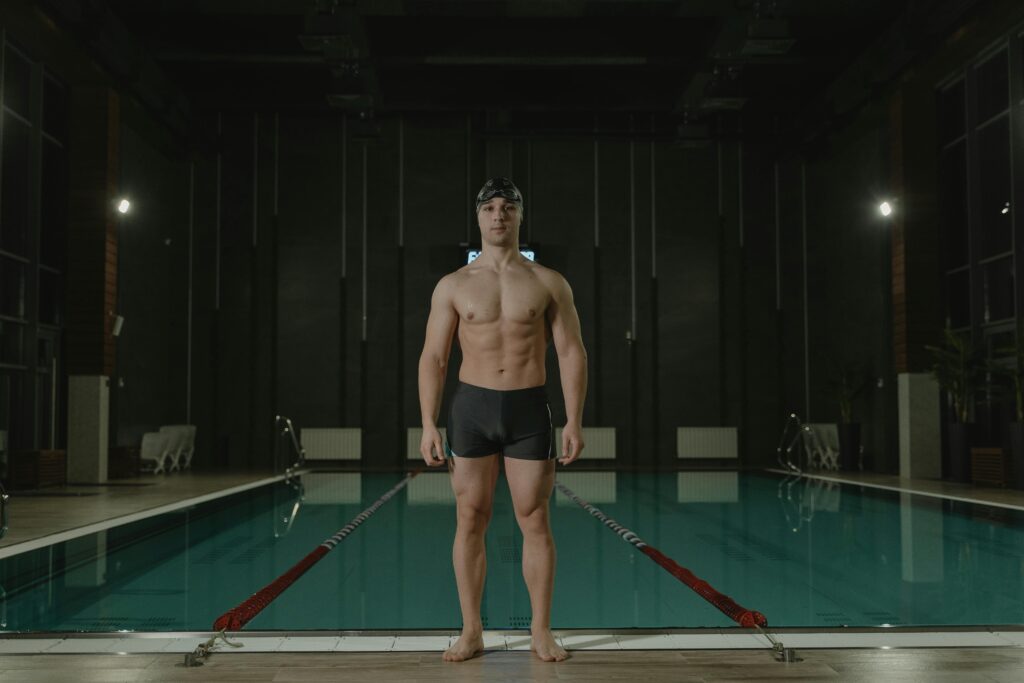
Freestyle and Butterfly: Contrast in Muscle Use
Freestyle and butterfly rely heavily on upper body strength. These strokes use the latissimus dorsi, pectoralis major, and deltoids for powerful arm movements. The legs provide a steady kick to maintain body position.
Breaststroke, in contrast, puts more stress on the legs. The frog-like kick engages the quadriceps, hamstrings, and calves more intensely. The arm movements are less circular, working the chest and shoulder muscles differently.
Butterfly uses a dolphin kick, which works the core muscles more than breaststroke. The undulating motion requires strong abdominals and lower back muscles.
Backstroke and Breaststroke: A Comparison
Backstroke, also known as back crawl, shares some similarities with breaststroke in muscle use. Both strokes engage the back muscles, including the latissimus dorsi and rhomboids.
Breaststroke requires greater output from the legs compared to backstroke. The whip-like kick in breaststroke works the inner thighs and glutes more intensely.
Arm movements in backstroke are more similar to freestyle, using shoulder and upper arm muscles in a rotating pattern. Breaststroke’s arm movements are unique, with a pulling and pushing motion that works the chest and biceps differently.
Backstroke puts less strain on the neck muscles as the face remains above water. Breaststroke requires more neck flexion to breathe, engaging these muscles more actively.
Benefits of Breaststroke for Strength and Endurance
Breaststroke swimming offers a range of benefits for improving physical fitness. It builds muscle strength, boosts endurance, and enhances cardiovascular health. The unique movements also promote flexibility and help tone various muscle groups.
Muscle Strength and Power
Breaststroke requires a high degree of power and strength. The leg kick, known as the frog kick, engages the quadriceps, hamstrings, and calves. This motion builds lower body strength over time.
The arm movements work the chest, shoulders, and triceps. The pulling action against water resistance helps develop upper body power.
Core muscles, including abs and obliques, stabilise the body during swimming. This improves overall core strength.
Endurance and Cardiovascular Health
Regular breaststroke swimming improves endurance and heart health. The continuous movement raises heart rate and increases lung capacity.
Swimming can lower the risk of heart disease and stroke by 41%. This makes breaststroke an excellent choice for cardiovascular fitness.
The stroke’s rhythm helps build stamina. Swimmers can maintain the pace for longer periods, boosting overall endurance.
Flexibility and Muscle Toning
Breaststroke enhances flexibility, especially in the hips, shoulders, and ankles. The wide arm and leg movements improve joint mobility and muscle elasticity.
The stroke tones multiple muscle groups. It works the chest, back, arms, legs, and core simultaneously.
Regular practice leads to a more streamlined physique. The resistance of water helps sculpt and define muscles without adding bulk.
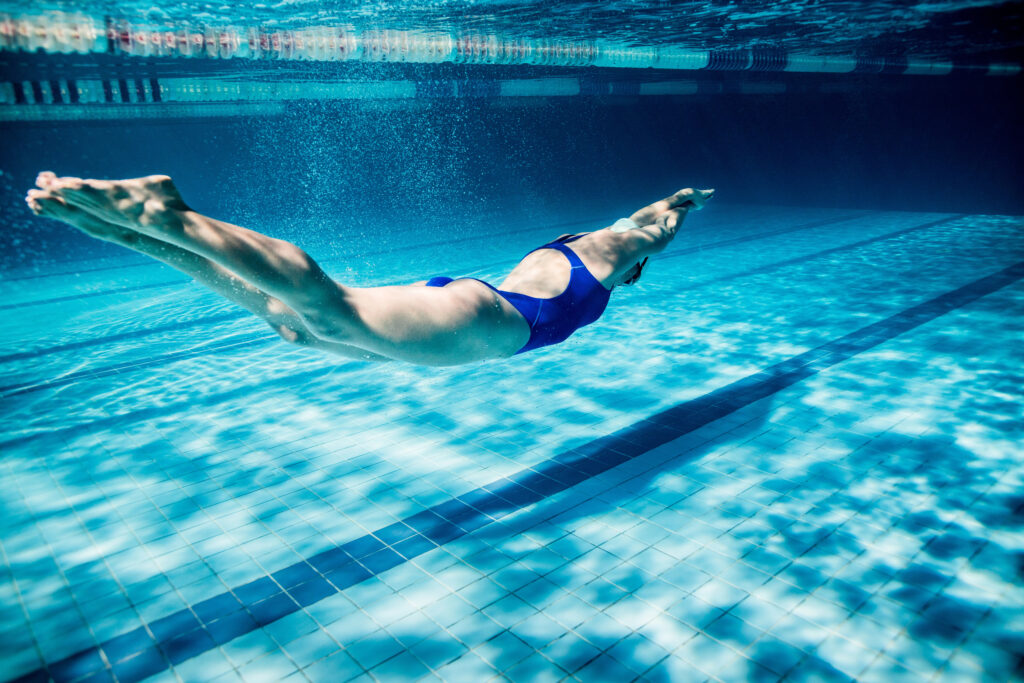
Improving Technique for Efficient Swimming
Mastering breaststroke technique enhances efficiency and speed in the water. Proper form reduces drag and maximises propulsion, leading to better performance.
Drills and Practice Strategies
Stroke training is crucial for improving breaststroke technique. Swimmers should focus on perfecting each phase of the stroke cycle.
One effective drill is the pull-kick drill. This involves isolating the arm and leg movements to refine coordination. Swimmers perform the arm pull followed by the leg kick, pausing briefly between each action.
Another useful exercise is the two-kicks-one-pull drill. This drill emphasises the leg thrust and helps swimmers develop a stronger kick.
Using fins during practice can help strengthen leg muscles and improve ankle flexibility. This leads to a more powerful propulsive phase.
Video analysis is a valuable tool for identifying areas for improvement. Swimmers can review their technique and make necessary adjustments.
The Importance of Streamlining
A streamlined body position is essential for reducing drag and increasing speed in breaststroke.
Swimmers should focus on maintaining a long, stretched position during the glide phase. This involves keeping the arms extended forward and the legs straight behind.
To improve streamlining, swimmers can practice push-offs from the wall. They should aim to travel as far as possible underwater before beginning the stroke cycle.
Core strength is vital for maintaining a streamlined position. Swimmers should incorporate exercises like planks and Superman holds into their dry-land training.
Flexibility in the shoulders and hips also contributes to better streamlining. Regular stretching routines can help improve range of motion in these areas.
Optimising Stroke Rate and Cadence
Finding the optimal stroke rate and cadence is crucial for efficient breaststroke swimming.
Swimmers should experiment with different stroke rates to find their most efficient rhythm. This may vary depending on the distance of the race.
A common mistake is taking too many strokes per length. This can lead to fatigue and reduced efficiency. Swimmers should focus on maximising distance per stroke.
Using a tempo trainer can help swimmers develop a consistent stroke rate. This device emits a beep at set intervals, allowing swimmers to synchronise their movements.
Practising with different tempos helps swimmers adapt to various race situations. They should be able to adjust their stroke rate without losing form or efficiency.
Breathing technique also affects stroke rate. Swimmers should practice taking quick, efficient breaths to maintain a smooth rhythm throughout the stroke cycle.
Injury Prevention and Rehabilitation
Swimming breaststroke can lead to specific injuries. Proper prevention and rehabilitation are crucial for swimmers to stay healthy and perform their best.
Common Breaststroke Injuries
Breaststroke swimmers often face unique challenges. Breaststroker’s knee is a common issue. This injury affects the inner part of the knee due to the whip-like kick motion.
Shoulder problems can also occur. The wide arm pull in breaststroke can strain the rotator cuff muscles.
Lower back pain is another concern. The arching motion during the stroke can put stress on the spine.
Muscle strains in the legs, particularly the hip adductors and groin muscles, are also frequent.
Rehabilitation Exercises
Proper rehabilitation is key for recovery. For knee injuries, focus on strengthening exercises for the quadriceps and hamstrings.
Shoulder rehab should include rotator cuff exercises. Use light weights or resistance bands for external and internal rotation movements.
For back issues, core strengthening is crucial. Planks and bird-dog exercises can help stabilise the spine.
Stretching is important for all injuries. Gentle stretches for the affected areas can improve flexibility and reduce pain.
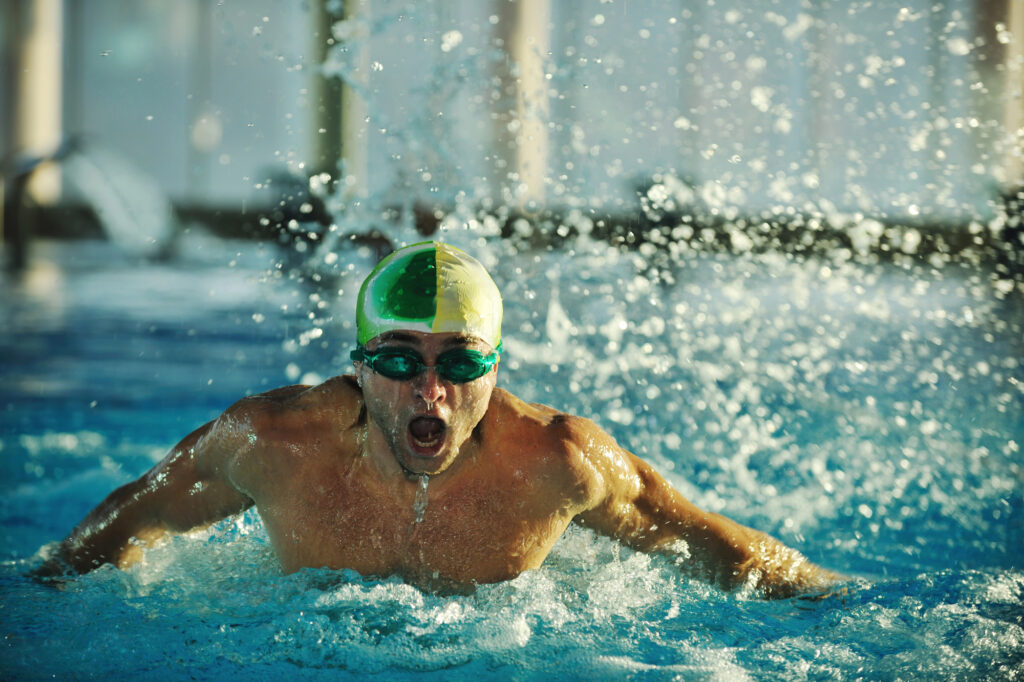
Preventive Measures and Dryland Exercises
Prevention is better than cure. Proper technique is essential to avoid injuries. Swimmers should work with coaches to ensure correct form.
Dryland training can boost strength and flexibility. Include exercises like:
- Squats and lunges for leg strength
- Push-ups and pull-ups for upper body power
- Core exercises like sit-ups and Russian twists
Stretching regularly is vital. Focus on hip flexors, hamstrings, and shoulders.
Cross-training with activities like yoga or Pilates can improve overall fitness and reduce injury risk.
Proper warm-up before swimming is crucial. Include dynamic stretches and light cardio to prepare the body.
Frequently Asked Questions
Breaststroke swimming engages multiple muscle groups throughout the body. It provides a comprehensive workout that targets both upper and lower body muscles in unique ways compared to other strokes.
Which muscle groups are primarily engaged during the breaststroke?
The major muscles used in breaststroke include the latissimus dorsi, pectoralis major, biceps, and triceps in the upper body. In the lower body, the glutes, quadriceps, and calves play crucial roles.
The core muscles, including the abdominals and lower back, are also engaged to maintain proper body position in the water.
Is the breaststroke effective for abdominal toning?
Breaststroke can be effective for abdominal toning. The stroke requires constant core engagement to maintain proper body position and execute the leg kick.
While not as intense as some targeted abdominal exercises, regular breaststroke swimming can contribute to overall core strength and tone.
How does breaststroke swimming impact the body’s musculature?
Breaststroke swimming provides a full-body workout. It strengthens and tones muscles in the upper back, chest, arms, legs, and core.
The repetitive nature of the stroke helps build muscular endurance. The resistance of the water also aids in muscle development and toning.
What are the differences in muscle use between breaststroke and other strokes?
Breaststroke engages the leg muscles more intensively than other strokes, particularly the inner thighs and calves. The arm movement in breaststroke works the chest and biceps more than in freestyle.
Compared to backstroke, breaststroke provides a more balanced workout for both upper and lower body muscles.
Can swimming breaststroke improve overall muscular strength?
Yes, swimming breaststroke can improve overall muscular strength. The resistance provided by the water creates a challenging environment for muscle engagement.
Regular breaststroke swimming can lead to increased strength in the chest, back, arms, legs, and core muscles.
What are the least targeted muscles when performing the breaststroke?
While breaststroke provides a comprehensive workout, some muscles are less targeted. The trapezius and shoulder muscles are not as heavily engaged as in other strokes like freestyle or butterfly.
The obliques and lower back muscles, while used for stabilisation, are not as intensively worked as the primary muscle groups involved in the stroke’s propulsive movements.

